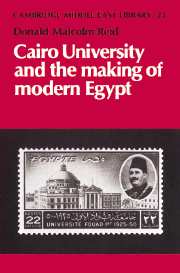Book contents
- Frontmatter
- Contents
- List of illustrations
- List of tables
- Acknowledgments
- Note on academic terminology and transliteration
- List of abbreviations
- Introduction
- Part I The private university, 1908–1919
- Part II The university and the liberal ideal, 1919–1950
- 4 The transition to a state university
- 5 Rival imperialisms and Egyptianization
- 6 Issues of equity: a university for whom?
- 7 The university and politics, 1930–1950
- 8 The issue of religion
- Part III In Nasser's shadow, 1950–1967
- Part IV The university since Nasser
- Conclusion and prospect
- Notes
- Select bibliography
- Index
6 - Issues of equity: a university for whom?
Published online by Cambridge University Press: 30 October 2009
- Frontmatter
- Contents
- List of illustrations
- List of tables
- Acknowledgments
- Note on academic terminology and transliteration
- List of abbreviations
- Introduction
- Part I The private university, 1908–1919
- Part II The university and the liberal ideal, 1919–1950
- 4 The transition to a state university
- 5 Rival imperialisms and Egyptianization
- 6 Issues of equity: a university for whom?
- 7 The university and politics, 1930–1950
- 8 The issue of religion
- Part III In Nasser's shadow, 1950–1967
- Part IV The university since Nasser
- Conclusion and prospect
- Notes
- Select bibliography
- Index
Summary
While the Anglo-French contest and the transition to an Egyptian professoriate were unfolding, the Egyptian University was also struggling to define its student constituency. Admission of students without regard to religion had never been at issue; controversy centered instead on admitting women and — hidden behind the rhetoric of educational qualifications — how open admissions should be to various social classes.
The challenge of coeducation
The private university closed its women's section in 1912, and Egyptian women retreated to the harem and to charitable work. They remained in the background during World War I, when British repression made public activism impossible. But feminism was not dead. A leading journal of the day, whose contributors included Taha Husayn and Muhammad Husayn Haykal, called itself al-Sufur, “The Unveiling.” It provides a link between the pre-war al-Jarida and the later al-Siyasa. Women returned to the public eye in 1919 as part of the national protest against British rule, then turned to specifically women's issues.
Organized Western feminism emerged only decades, not centuries, ahead of its Egyptian and Ottoman counterparts. This should not be surprising, for modern feminism everywhere was bound up with the changing circumstances accompanying the rise of a capitalist-driven world economy.
- Type
- Chapter
- Information
- Cairo University and the Making of Modern Egypt , pp. 103 - 119Publisher: Cambridge University PressPrint publication year: 1990



